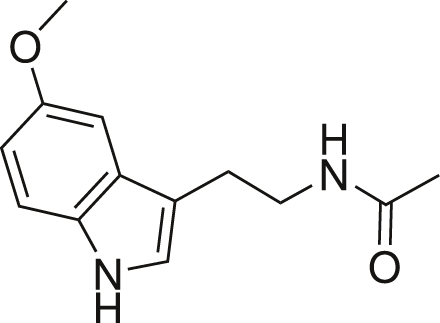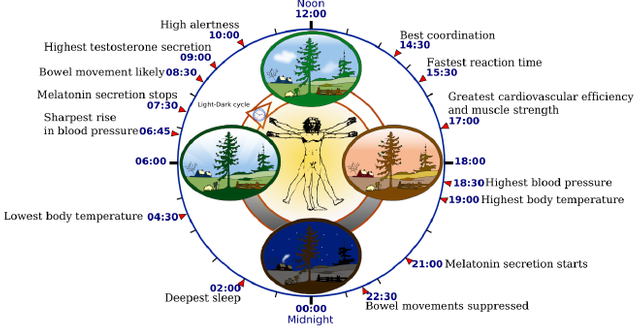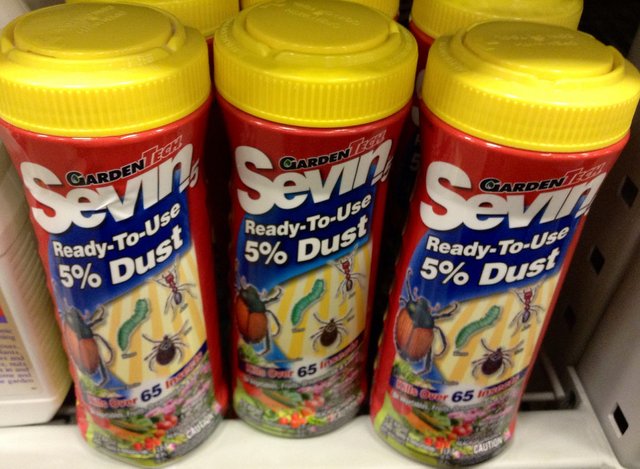Common Insecticides Mimic Melatonin And Disrupt Human Circadian Rythems
How do you all feel about insecticide use? When you garden have you ever sprayed your plants with one? If you have you may want to take a look at what variety you are using and stop or change to something else...

In an article published on Dec 27 2016 in the Journal: Chemical Research in Toxicology titled "Carbamate Insecticides Target Human Melatonin Receptors" researchers have found that a certain class of insecticide, the Carbamate is able to bind to receptors through out the body responsible for interacting with the hormone Melatonin.
What is Melatonin?
Melatonin or N-acetyl-5-methoxy tryptamine is a hormone produced by the pineal gland in the brain.

Melatonin binds to receptors throughout the body named melatonin receptors (yeah... not much creativity going on there, but at this point if you have been following my blog you likely already know that creative nomenclature and scientists do not see eye to eye) of which there are three varieties (MR1, MR2, and MR3 where MR just means melatonin receptor).
These receptors are located in a variety of locations including the brain, retina, cardiovascular system, heart, arteries and veins, liver and gallbladder, colon, skin, kidney, cells of immune system, platelets, and even fat cells. This should tell you that interaction with melatonin has the potential to affect quite a wide variety of bodily systems and for good reason! ([Source](
Melatonin, through interaction with melatonin receptors is responsible for maintenance of circadian rhythms which include our sleep-wake cycle, and other seasonal rythms. In addition to this melatonin also acts as an immunostimulator through increasing production of the precursor cells that become macrophages (the cells that engulf and eat invading pathogens... nom nom). (Source 1, Source 2)
What is a Circadian Rhythm?
In essence a circadian rhythm is just a 24 hour repeating biological cycle. For the purpose of this post the most important circadian rhythm is our sleep-wake cycle:

You will notice that this cycle involves both a ramping up of melatonin secretion as well as a decline in melatonin secretion, meaning the interaction between this hormone and the various melatonin receptors throughout our body are extremely important in maintaining the sleep-wake cycle and keeping our bodies functioning properly.
The Authors Found That Carbamate Insecticides Mimic Melatonin and Can Bind to the MR1 and MR2 Melatonin Receptors
What is a Carbamate Insecticide?
The class that is not the organophosphate class that everyone complains about. Reported illnesses from this class of insecticide are supposedly "shorter and easier to treat" then are illnesses from organophosphate exposure. These are the pesticides most commonly used by home gardeners. One such prominent ( 1/3 of all home insecticide use is this compound) home insecticide Carbaryl is a carbamate class insecticide, and is sold (by Bayer) under the name Sevin:

It is already classified as a potential carcinogen due to its mechanism of action as a acetylcholineesterase inhibitor. The functioning of which is important for maintaining appropriate neural functioning by breaking down excess acetylcholine.
What Carbamate Insecticides Were The Researchers Looking At?
Carbofuran a very toxic insecticide not common for home use and Carbaryl (oh shit... the one I was just talking about).
What Were They Studying and What Did They Find In Their Studies?
They began with computer docking simulations using these compounds looking at whether or not they would fit into the binding pocket for the melanin receptors MR1 and MR2. They found, unsurprisingly that melatonin was able to fit easily into the binding pocket for these receptors (as it should... its what actually binds there), but they also found that carbaryl and carbofuran could also be placed into the binding sites. However the models indicated that the "goodness" of fit was best for melatonin followed second by carbaryl and finally least good for carbofuran. That's fine and good, but it's still a computer simulation, what about testing whether these compounds can actually bind to the receptors (yes... yes... do some protein binding studies!!! Sorry I get excited when reading about people doing what I do), so they left their computers and went to the bench.
Here they measured the binding by competition experiments, what I mean by this is they utilized a radioactively tagged version of melatonin (using Iodine-125) and bound it to the receptors.

They then added increasing concentrations of each of the two pesticides (individually) and studied how much was necessary to get the radioactive labeled melatonin to come off. What they found was that the affinity of melatonin was 8000 times tighter then carbaryl for binding to MR1 but only ~200 times tighter for binding to MR2.
It's good that melatonin binds more tightly, but the insecticides CAN still bind.
Authors Conclusions
Environmental exposure to these environmental chemicals may disrupt the homeostatic balance between neurotransmitter and modulators in target tissues expressing melatonin receptors.
What they mean is that these compounds could bind to your melatonin receptors and disrupt the normal signaling that they are responsible for. As we already mentioned the binding of melatonin to these receptors is integral to maintaining your sleep-wake cycle, so the binding of these compounds could interfere with that in some capacity.
What Issues Can Arise From Disrupted Sleep Wake Cycle?
Studies have shown a link between poor sleep and diabetes, hypertension, obesity and depression. So exposure to carbamate insecticides based on these binding studies draws a potential link between exposure and an increased potential for the aforementioned chronic health issues.
Hopefully more studies will now be done to look at this potential interaction outlined in the study described above, considering the prevalence of this particular class of insecticides in home gardening.
If you are employing any of these chemicals in your own gardens, perhaps consider looking into alternative methods of pest control. Maybe it isn't necessary, and in time further research will show that there is no adverse effect on humans from exposure (perhaps the weak binding is not enough to cause a physiological response!), however we can only decide based on the information we have available.
# Sources
- http://pubs.acs.org/doi/pdf/10.1021/acs.chemrestox.6b00301
- https://en.wikipedia.org/wiki/Melatonin
- https://www.ncbi.nlm.nih.gov/pmc/articles/PMC4970552/
- http://www.sciencedirect.com/science/article/pii/S1357272505002736
- https://www.ncbi.nlm.nih.gov/pmc/articles/PMC1325257/
- https://www.sciencedaily.com/terms/circadian_rhythm.htm
- https://www.cdc.gov/nceh/clusters/Fallon/Glossary-Non%20Pers.pdf
- https://en.wikipedia.org/wiki/Carbaryl
- https://en.wikipedia.org/wiki/Acetylcholine
All non Cited Images Are Available Under Creative Commons Licenses
Any Gifs Are From Giphy.com and Are Also Available for Use Under Creative Commons Licences
If you like my work, please consider giving me a follow: @justtryme90. I am a PhD holding biochemist with a love for science. My future science blog posts will cover a range of topics in the biology/chemistry fields.
Thank you for your continued support of my work! I appreciate all those who follow me (and those who don't too).
We are paying more and more attention to what we buy, checking in particular the usage of pesticides (when we can check of course). At the end, we are not trusting much the big companies anymore and trying to visit as much as possible local (possibly organic, possible not) shops where we can at least chat with the owner/producers. This is not the best, but at least we have some human contacts and that's good.
PS: I hope not too many students died during the time you wrote the article... ;)
I am still not sure what to make of all of this, I certainly won't be using any sevin on anything I grow this coming season!
Lets hope none opened any vials of Iodine-125!!!
We like to try natural 'pesticide' on our garden. It is in addition more funny (imagine my 5-years-old son seeing is father preparing bowls with beer to trap slugs).
I have heard that ladybirds work well, as well as (according to my Mum at least) egg shells help to deter snails and slugs.
Ladybirds may be not so convenient to keep in a fridge :D
But we use the egg shells a lot, and this works very well. For the beer, I am less convinced honestly. But anything non-industrial deserves a try.
Yes safety first I think:)
To complicate the matter further, most pesticides and herbicides are formulated with harmful inert ingredients that are rarely disclosed to consumers.
Thank you for spreading awareness!
Thank you for reading :)
Synchronicity! I posted on the same thing:)
https://twitter.com/Soul_Eater_43/status/823289932382924801
It was an interesting article, and a bit concerning. For anyone reading here also check out @thecryptofiend's post:
https://steemit.com/health/@thecryptofiend/two-commonly-used-pesticides-may-be-interfering-with-melatonin-and-causing-disease
They say, great minds think alike.
Lol. What did you think about the computer modelling they used to isolate these 2 compounds as interacting? I haven't come across that before. I thought you might be more familiar with it.
Docking models are pretty common for looking at whether a small molecule can fit into an enzyme active site. They basically just use a protein crystal structure and try to see how many different geometric conformations they can find to make something fit. They are sort of "hand-wavey" but are a good first step to seeing whether an interaction is possible. The researchers here did it right, they saw something interesting by the docking model, then actually went and looked directly at binding (by competition assays) for the pesticides to the melatonin receptor.
Cool. It is a while since I have done research and in those cases it was usually the latter stages so all this kind of thing I suspect had already been done by then - I suspect the simulations will only continue to get more advanced via Moore's law (assuming it holds out).
I see Sevin Dust in the photo...I assume that it is one of the culprits? Let me know so I can advise others please. I only use tobacco juice as an insecticide. It's natural and non toxic to humans (in this capacity)
Yep, the active compound in Sevin is the one studied compound Carbaryl.
Several people I know treat their lawns to keep the flea population down, I'll inform them. This is something they need to know about!
I think moskitos do disrupt circadian rythmes much more then any incectisides ;)
But insecticides do kill also these insects which we need to pollinate our plants (and plants in general). Did you know that in some regions of China farmers need to pollinate their plants manually because they have killed nearly all bees and bumblebees already? But China is by far not the only country where populations of useful insects are decreasing because of ... us.
One source (there are many): https://www.chinadialogue.net/article/show/single/en/5193-Decline-of-bees-forces-China-s-apple-farmers-to-pollinate-by-hand
Yes, I do realise that.
Here in Russia a few years ago I had a walk with my friends from England and that was a time when lots of butterflies emerged. They told me that they hasn't seen it since theyr childhood like 50 years ago, aftet that incectisides took over.
Thank you for your comment
Edits to fix grammar, capitalization, a misspelled word and to spread out the text in a few of the larger paragraphs for ease of reading.